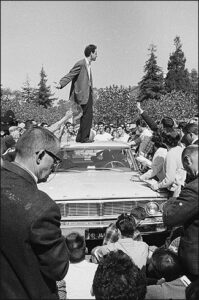
Mario Savio, leader of the Free Speech Movement at UC Berkeley in 1964, stands on a car to address a spontaneous assembly.
One of the most discouraging and widespread forms of censorship in the US today is the frequent outright suppression of student speech in high schools and occasional censorship at universities.
Students working on high school newspapers, yearbooks, video classes and web sites are routinely told by high school officials that they cannot print articles on even the mildest controversies. As a result, there has been an enormous decrease in the number of student publications and a decline in appreciation for the public service role of the news media.
Despite a long history of support for free speech for students in cases such as Tinker v Des Moines (1969), the Supreme Court in 1988 reversed itself and allowed schools to censor school publications in Hazelwood School District et al. v. Kuhlmeier et al. It’s important to note that the Hazelwood decision involves high school and not college publications, and that official censorship of college publications is not usually tolerated by the courts.
Nevertheless, since only about one third of Americans graduate from college, the experience of censorship in high school tends to leave a lasting impression for many. The author of Lessons in Censorship, Catherine J. Ross, says that student expression needs to be protected for the sake of democratic values.
When schools curb speech, students don’t learn why free expression is critical to democracy. Instead, they receive a message that free speech can be sacrificed for a competing social good. That message undermines an unwavering First Amendment premise: The best cure for objectionable speech is more and better speech.
Those who would silence the diverse viewpoints of the young, whether in elementary school or at a university, should heed the Supreme Court’s advice in the Tinker casethat free speech isn’t always easy: “Any word spoken, in class, in the lunchroom, or on the campus, that deviates from the views of another person may start an argument or cause a disturbance. But our Constitution says we must take this risk.”
In Bethel School District v Fraser 1985, the Supreme Court said that suspending a student following a lewd and disruptive public speech at a high school could be grounds for suspension.
“Bong Hits 4 Jesus” — The Morse v. Frederick (2007) case involved a high school student named Joseph Frederick who displayed a 14-foot banner that read “Bong Hits 4 Jesus” during the 2002 Winter Olympics torch relay. The banner was displayed across the street from the school. Frederick was suspended for 10 days, and he sued, saying his constitutional rights to free speech were violated.
The US Supreme Court ruled that public school officials can censor student speech that they reasonably believe encourages illegal drug use without violating a student’s First Amendment rights.
Mahoney Area School District v B.L., 2020, the court said a cheerleader should not have been suspended for statements made off campus on social media. The school’s interest in punishing her use of vulgar language was “weakened considerably by the fact that B. L. spoke outside the school on her own time.”
University Censorship
Although outright censorship is not constitutional on public college campuses, there have been many instances of it over the years and at certain universities.
One kind of censorship that seems to particularly outrage conservative media involves conservative speakers that have been cancelled or shouted down. The Murdoch media (UK Daily Mail, NY Post, Fox News) frequently rail at the “leftist censorship (and the) progressive mob’s cynical drive to silence you and wage war on The West.” Although such incidents are rare, a typical article from the Daily Mail, Dec. 31, 2022, explains this perspective.
Another kind of censorship involves laws that seem too trivial to take into court but have a significant impact on small groups of people. The city of Radford, Virginia (for example) has prohibited the display of fraternity and sorority signs for decades without being challenged in court, despite the fact that the regulation is content-specific and therefore should be subject to strict scrutiny.
Two US organizations have been fighting for free speech rights:
- The Student Press Law Center says it is an advocate for student First Amendment rights, for freedom of online speech, and for open government on campus. The SPLC provides information, training and legal assistance at no charge to student journalists and the educators who work with them.
- The Foundation for Individual Rights in Education says it fights for freedom of speech, legal equality, due process, religious liberty, and sanctity of conscience—the essential qualities of individual liberty and dignity. FIRE’s core mission is to protect the unprotected and to educate the public and communities of concerned Americans about the threats to these rights on our campuses and about the means to preserve them.
A 2020 survey reported in “The First Amendment on Campus,” by the Knight Foundation showed that:
- Students want campus to be a place where they are exposed to all types of speech, even if it’s offensive — but also favor designated safe spaces and restrictions on speech that may explicitly target race or ethnicity.
- Wide racial and gender gaps exist in the extent to which students feel the First Amendment protects them.
- Students see free speech as increasingly less secure since 2016, and rank it as the least secure of all First Amendment freedoms in 2019
More information
- RU Speechless – A Radford University class on free speech in universities. One issue in Radford is an obviously unconstitutional prohibition of fraternity and sorority signs.
- Lessons in Censorship — A 2015 book about censorship in schools
